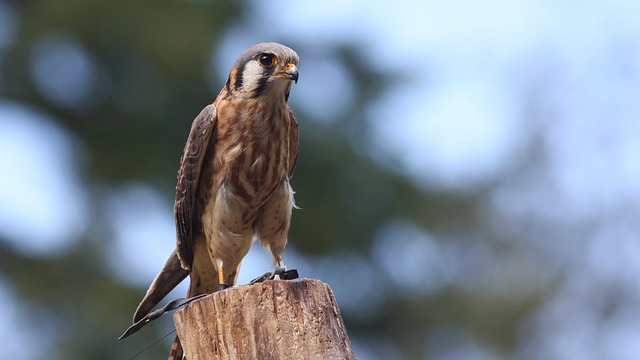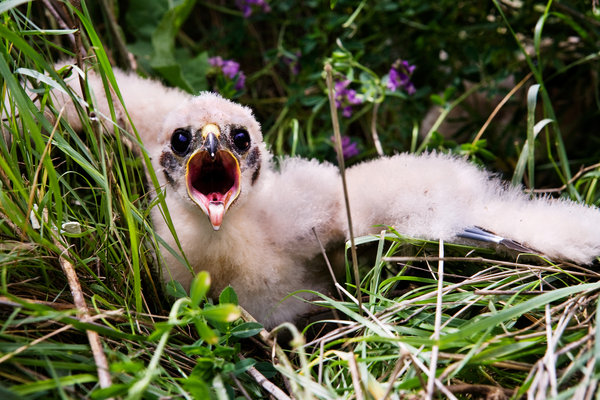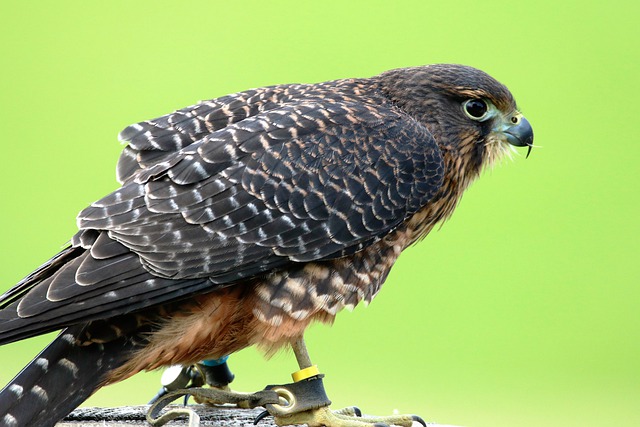Small to medium-sized daylight or diurnal hunters, falcons are members of the genus Falco.
Falcons in North America can weigh between 2.8 ounces and 4.5 pounds.
There are 8 different species of falcons in North America. There are over 40 species of falcons around the world.
These birds are expert hunters, using their hooked beaks and pointed claws to capture and consume their prey.
They feed on reptiles, birds, insects, amphibians, and mammals.
| Image | Name |
|---|---|
 | American Kestrel |
 | Merlin Falcon |
 | Gyrfalcon |
 | Peregrine Falcon |
 | Prairie Falcon |
 | Aplomado Falcon |
Types of Falcons in North America
1. American Kestrel

The bird typically resides near wide-open fields. As it looks for a prey, it hovers or perches on a high vantage point.
It features a tail with a square-like tip and wings that are thin, pointed, and falcon-shaped. The bird has swept-back wings and flies with agility and buoyancy.
Both sexes have falcon-typical dark eyes, and the face features two large, dark mustache marks that frame the white cheeks.
In the air, falcons are renowned for their swiftness and dexterity. The American kestrel is no exception, with its ability to swiftly change directions.
They hunt by sight rather than sound, unlike several other species of raptors. They can surprise animals on the ground by keeping an eye out for places where they tend to gather or travel.
In contrast to humans, birds can perceive UV light. This makes it simple for the kestrel to find pee tracks that their prey left behind on the ground.
The keen “kee-aah” call of the American kestrel. In order to alert other birds when it feels threatened, it can also make a rattling trill.
Mating
The bird makes use of dirt banks, dead trees, gigantic hollow cacti in the Southwest, and cavity nests during the breeding season.
On tall telephone poles and trees, it can also use nest boxes. The sparrow hawk has the ability to raise up to 5 or 6 young, depending on the amount of food available.
Hunting
The sparrow hawk hunts by perching and scanning the ground for prey while adopting energy-saving methods. But it also uses the air to hunt.
Insects like grasshoppers, little birds, reptiles, and mice make up the bird’s food. The success of the species has been greatly influenced by its varied diet.
Breeders from the north migrate to their wintering grounds in Southern America and Northern Mexico along the classic fall migration paths. In comparison to inland corridors, the Eastern inhabitants migrate more along the coasts.
Most of these birds stay in the Southern United States during the winter. Especially in agricultural areas, you can observe them dispersed among telephone poles, searching the area for prey.
The number of birds wintering in the area is determined by the food supplies in states covered in snow.
2. Merlin Falcon

The tiny, dark-colored Merlin falcon is also called the Pigeon Hawk. The wide areas of Canada, Alaska, and the northern and western regions of the continental United States are among the regions in North America where this rare bird breeds. Additionally, the Merlin breeds in various regions of Asia and Europe.
American Kestrels are slightly bigger than Merlins. Merlin has a long tail and long, narrow wings like other falcons do. The bird can now take active flight thanks to this.
The merlin falcon can live everywhere, including tundra, prairies, and deserts, as long as there are shrubs nearby where it can lay its nest.
A male merlin falcon’s wingspan ranges from 21 to 23 inches (53 to 58 cm), but females have somewhat larger wings.
These predators tend to favor wide spaces in their habitat, including lawns or meadows, where their sharp eyes may quickly spot potential victims.
Merlins hunt by flying close to the ground and attempting to catch their prey off guard. They will only suddenly rise to grasp the prey in their claws and transport it back to a perch, where they will kill and consume it.
Mating
The Merlin Falcon only has one partner. Breeding pairs spend the winter apart, and in the spring, they either build new bonds or strengthen existing ones.
The same breeding location and nesting territory are frequently reoccupied by the birds. It is uncommon for them to reuse a specific nesting place. One month earlier than female Merlins, male Merlins return to their breeding grounds. Females could spend the entire year in the nesting location.
The species borrows other birds’ abandoned nests, particularly those of raptors and magpies, rather than building its own. Additionally, they make depressions in the ground or nest in a tree, or build cavities or ledges on cliffs.
Hunting
On the wing and from perches, merlins do the hunt. Merlins use surprise when hunting. They mostly employ this approach when hunting from covert perches and when flushing prey from below the canopy.
The bird will occasionally employ topography, such as hills, to conceal its approach. The bird hunts most actively in the early morning and late afternoon.
3. Gyrfalcon

The largest type of falcon is the Gyrfalcon. Gyrfalcons typically have white bodies and black spots.
These birds rule over the barren high Arctic shores as vicious predators. The Gyrfalcon feeds on large birds like ducks and ptarmigans in this area. They outperform their victim in terms of speed and power.
While some of these birds move south to the area near the Canadian border during the winter, the majority of these birds stay in the north all year.
When a gyrfalcon is young, its wings are typically light brown with black markings. Their feathers nearly totally become white as they get older.
Gyrfalcons are huge, powerful birds with yellow eyes and large feet. They weigh up to 4.6 pounds, have a vast wingspan of almost six feet, and are 19 to 25.5 inches (48 to 65 cm) long.
Due to their power, these birds are frequently utilized in falconry.
They were treasured in the past as emblems of strength and valor. They continue to be very well-liked by hunters and bird watchers in the current era.
Mating
Late in January, male gyrfalcons start guarding their breeding grounds. In March, females start to show up at nesting locations. Nesting begins for pairs in April.
The majority of bird nesting locations are found high up on cliffs or in old nests that other birds like ravens and golden eagles have erected. No new materials are added to the Gyrfalcon’s existing nest.
Three to five eggs are laid by female gyrfalcons, and they are incubated for around five weeks. While both parents participate in incubation, the female is mostly responsible.
For the first one to three weeks, the female spends the majority of her time caring for the young while the male conducts the majority of the hunting. Two or three weeks later, both parents go hunting.
The chicks will make their first flight after 45 to 50 days.
Male gyrfalcons execute aerial shows around their nest, diving and rolling. The two will guard a region that is almost a mile broad. Nesting areas are positioned between three and sixty kilometers from the closest pair.
Hunting
The Gyrfalcon hunts by flying or perched high on a rock and examining its surroundings. The bird uses a surprise approach to hunting. It pursues huge and hefty birds like geese, gulls, and ducks.
Additionally, the Gyrfalcon pursues small mammals, including ground squirrels, lemmings, and hares. Researchers have observed wintering gyrfalcons stealing huge birds like the sage grouse on multiple occasions.
4. Peregrine Falcon

Over most of North America, peregrine falcons are the largest species of falcon. The only larger bird is the Gyrfalcon. The size of a peregrine is comparable to a crow. They have grey bars on top of the white below.
In terms of hunting prey, it is among the best falcons. It can grab prey that is moving too quickly for other falcons to catch because it can fly at rates of up to 200 mph.
Despite being a diminutive species, this falcon is really impressive. The fastest mammal currently living. Even Formula 1 cars cannot keep up with their top speed of 240 mph (390 kph).
The peregrine falcon weighs 1.5 to 2 pounds and has a body length of 17 to 20 inches. The peregrine falcon’s female counterpart is bigger than the male, who plays a more maternal role.
Brown feathers that create a unique cap over their heads cover the heads and throats of these birds. The “sideburns” that give the species its name are a thin black-tipped stripe along their cheek and chin sides and two spots close to their beaks.
Mating
To entice a mate, males perform airborne courtship displays. The female has the option. Lifelong partners are found among peregrine falcons.
If the first mate is murdered, the female might accept a new one. Some of these birds’ nesting locations have been used by numerous succeeding generations for hundreds of years.
Hunting
Peregrine falcons, also called duck hawks, hunt other birds as they are flying. These animals hunt from the air. When they spot their prey, they drive quickly at over 200 mph while dropping in a sweep.
An estimated 1,500–2,000 bird species are preyed upon by peregrine falcons, according to researchers. However, they frequently hunt songbirds and medium-sized birds, including waterfowl, waders, pigeons, and doves.
The bird thrives in coastal areas where shorebirds are plentiful and enjoys open areas. However, they can be found anywhere, even in the arctic and deserts. The Peregrines can be found residing atop bridges and towers in large cities.
Those who spend their winters in South America and build their nests in the Arctic travel up to 15,500 miles yearly. The homing instinct of the birds directs them to return to their favorite locations.
5. Prairie Falcon

In terms of size, the prairie falcon is comparable to the peregrine falcon. But they are designated somewhat differently.
The topsides of prairie falcons are brown, and their breasts and bellies are whitish with brown markings. From below, their wings appear dark. In contrast to their back and wings, their tail is pale when viewed from the top.
Even new habitats, like airports, have been made available to some prairie falcons.
The presence of grasslands and other open spaces near many airports makes them perfect homes for prairie falcons.
These are little birds with an average wingspan of 40–45 inches and a weight of around 1.6 pounds.
Mating
At the nesting site during the breeding season, the male engages in aerial gymnastics. The majority of nesting occurs in a recessed area, on a cliff ledge, or on rocks.
The bird may occasionally build its nest on a dirt bank or in an abandoned nest built by another bird, particularly a raven.
The white eggs with brown markings that the Prairie Falcon’s female lays range in number from three to six. A 31-day incubation period is typical.
The male may sit on the eggs while the female is feeding while also hunting and bringing food to the female who is incubating.
The female stays with the infant for the first four weeks while the male provides nourishment. After hatching, the young might leave the nest between five and six weeks.
Hunting
In addition, prairie falcons hunt differently from peregrines. To surprise their prey, they prefer to fly quickly and low over the terrain.
They may also quickly and steeply drop from the air or follow birds that are flying. Prairie falcons consume birds and small mammals for food.
In the early summer, they frequently hunt ground squirrels. During the winter, they concentrate on singing birds as well as flocking birds like Horned Larks.
The Prairie Falcon can adapt to changed settings but is most prevalent in desert wilderness and barren plains. During the winter, the bird species glide over cities in the southwest.
6. Aplomado Falcon

The Aplomado is a falcon of average size. Similar to the American Kestrel in color but larger and bolder in size is the species.
Its facial stripes are black and white, while its underparts are tricolored. The tail of the species is black with fine white and grey bars and a white tip.
In the United States, the Aplomado Falcon inhabits deserts with sporadic mesquites and yuccas. The bird inhabits coastal savannas, marshes, and woodland borders near grasslands in Mexico.
South America makes up the largest portion of this bird’s range.
This species of falcon normally has a body length of 12–16 inches (30–40 cm) and a wingspan of 26–36 inches (67-90 cm).
The Aplomado Falcon has a body covered in feathers that are dark brown, red, and black, and its chest has horizontal white stripes.
It consumes rodents, canards, doves, tiny lizards, snakes, and Cracidae (curassows). They eat meat, much like all other falcons.
The Aplomado falcon prefers to hunt in open woodlands, grasslands, and savannas.
Mating
The species builds its nests in oak woodlands, trees, woody regions next to wetlands, and yuccas in open grasslands. Instead of making their own nets, they make use of abandoned stick nests made by crows, magpies, raptors, and jays.
The male and female start to show to one another at the start of the mating season. They may engage in aerial displays, loud calls, and private “e-chups” as part of their courtship activity. They might also trade food products.
Hunting
Aplomados consume lizards, tiny birds, animals, insects, and other food items. The bird hunts insects and small birds on the fly or pursues prey on foot.
The birds cooperate when they are hunting in pairs. While the other bird intercepts the victim, the first bird frightens it.
In flight, the Aplomado Falcon is incredibly strong and swift, easily outrunning White-winged Doves. To pursue prey, it can also move quickly on the ground.
When roosting, the majority of these falcons rest on inner tree limbs. Both males and females travel from one perch to the next and chase each other quickly throughout the mating season.
Conclusion
The United States is home to a wide variety of falcon species. Falcons are raptors that live all over the planet.
They inhabit a variety of environments and consume other birds as well as insects, rodents, and reptiles.
Falcons typically have long wings relative to their body length because they hunt with speed and agility.
North America provides a home to numerous falcon species, all of which took their names from other bird species.
FAQ
What Species Of Falcon Is Most Prevalent In North America?
The smallest and most prevalent falcon in North America is the American kestrel, or sparrow hawk (Falco sparverius).
Are Falcons Naturally Found In North America?
There are at least eight different species of falcons that are native to or have traveled to North America. Native birds with the broadest ranges include the Peregrine and Prairie falcons. The Gyrfalcon is a bird that inhabits Canada’s and Alaska’s far north and likes colder climates.
What Kind Of Hawks Are Falcons?
The answer to the frequently asked question of whether falcons are actually hawks is no. In contrast to hawks, falcons have longer tails and shorter wings, which enable them to fly with more maneuverability over the dense vegetation they usually inhabit.
How Did The Peregrine Falcon Recover From Extinction?
In 1974, the Peregrine Fund was started. It began a mission to rescue and restore the peregrine falcon, working with numerous organizations in both the United States and Canada.
Peregrine falcons were successfully produced in captivity by Cornell University researchers. In a lab, Peregrine falcon eggs were hatched. Up until the age of three weeks, the chicks were nurtured in the lab.
When their survival abilities were sufficiently developed for them to become independent, they were then put in artificial nesting sites where they were fed and cared for by unseen humans.
This method has allowed for the release of over 6,000 American Peregrine falcons in North America since 1974.
Populations of Peregrines are currently healthy in the United States and Canada, and in some parts of the world, they may even be more numerous than they were before the species’ fall in the 20th century.
Last Updated on March 22, 2023 by Lily Aldrin
